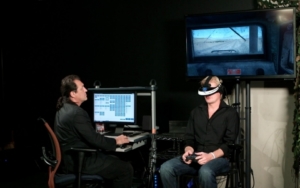Virtual Reality Therapy Recognized as a Treatment for Trauma

By Debbie Gregory.
Re-adjusting to being a civilian can be a tough transition, especially when accompanied by insomnia, irritability and anger issues.
Clinical psychologist Skip Rizzo at the University of Southern California Institute of Creative Technologies is using a new and unexpected way to treat post-traumatic stress disorder – with virtual reality (VR.)
According to the National Center for PTSD, some 8 million adults suffer from PTSD during a given year. PTSD can occur following a significant stressor, and often includes symptoms such as avoidance and hyper-vigilance.
One common method for treatment is called “exposure therapy.” The patient recounts their trauma, visualizing it in their imagination, and narrates it to a clinician. By repeatedly confronting and processing the trauma, the brain can start to reduce the level of anxiety and response to those memories.
Even though virtual reality itself is still a hard-to-grasp idea for most people who have not experienced it, the clinical use for VR as therapy has been generating a “rich scientific literature” for the past 20 years
That’s exactly the approach Rizzo uses with virtual reality therapy. I have been lucky enough to meet Rizzo and see his treatment in action.
“My mission is to drag psychology kicking and screaming into the 21st century,” Rizzo said, noting that virtual reality offers a unique opportunity for clinicians and clients alike: to be immersed in the environment that evokes the original trauma, rather than relying on the patient’s imagination.
Rizzo has created 14 virtual worlds for patients, and clinicians can add custom elements, including helicopters, clouds, small-arms fire and missiles.
Each session lasts for about an hour and a half, and the patient speaks about their experience with a clinician as they go through the virtual simulation. Although they can never replicate an exact simulation of what the patient went through, they really don’t need to.
Military Connection salutes and proudly serves veterans and service members in the Army, Navy, Air Force, Marines, Coast Guard, Guard and Reserve, and their families.

















